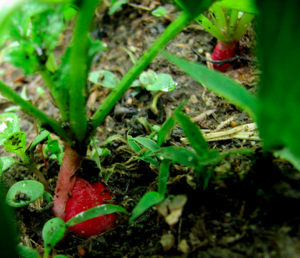
Radish (Raphanus sativus) is a quick and easy food crop to grow. Most radishes are grown for their roots. However, there are some varieties of radish that are grown for their edible leaves or pods and in some cases, radishes are grown as oilseed crops.
There are different varieties of radish, including the usual round red or red and white varieties, and the interesting varieties such as long radishes, "French Dressing" (pink) and "White Icicle" (white).
Radishes are both annual and biennial, depending on the variety.
Description[edit | edit source]
The standard garden radish is the annual summer radish. Its roots can be red, pink, white, purple, yellow-golden or bicoloured. The flesh is usually white but may have a reddish or pinkish tinge carried through.
Biennial radishes tend to be larger than annual radishes. Black Spanish radishes are black or dark-brown in skin colour and have white flesh. Daikon radishes are white or whitish-green on the skin, with a white flesh. Some biennial varieties have a pink flesh, namely Watermelon and Red Meat.
Growing radishes[edit | edit source]
Sow seeds, as they will germinate quickly. Sow during cool days in spring and autumn (fall). Sow directly where you wish the radishes to grow. Radishes like cool weather the most, which makes spring and autumn the best growing seasons unless your summer climate is quite mild.
Harvest within two to three weeks. Replace with new seed as you harvest the ready radishes. That way, you can have radishes throughout the spring and summer seasons.
If growing for seeds, expect to wait up to 4 months for the plant to flower and produce seeds.
Uses for radishes[edit | edit source]
Enjoy the radish root whole or sliced in salads and soups.
The shoots and leaves are also edible. Radish greens are tasty and nutritious.
Musings about radishes from readers[edit | edit source]
- I knew a fellow once who planted two rows of radish seeds, thinking that one in ten would sprout. Instead, he received at least 150% germination (a mathematical impossibility - I know) and ended up feeding ninety percent of them to the goats. Wonder that goat milk tasted like?!
See also[edit | edit source]
- Daikon (radishes with a hotter flavour)
- Root crops (NRI, 1987, 308 p.), Chapter 27
- Growing radishes in containers